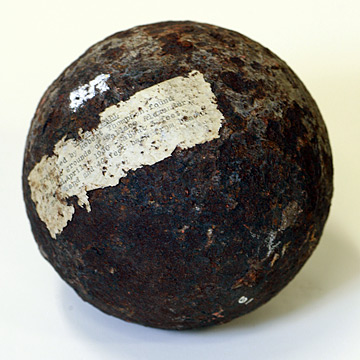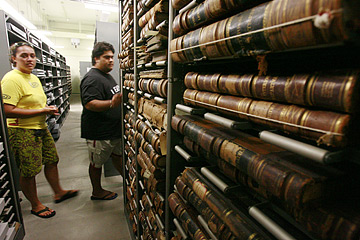 CINDY ELLEN RUSSEL / CRUSSELL@STARBULLETIN.COM
CINDY ELLEN RUSSEL / CRUSSELL@STARBULLETIN.COM
Commander cross worn by the High Grand Officer, Insignia of the Royal Order of Kapiolani. |
History's home
The 100-year-old repository offers a fascinating look into Hawaii's past
ROCKET SCIENTIST Werner von Braun once sighed, "We can lick gravity, but sometimes the paperwork is overwhelming." Particularly in government. Piles of files, stacks of facts. And it all has to go somewhere.
Pretty much, it all rolls downhill and winds up in the archives, for a government without a paper trail is no real government at all. In Hawaii, that means the State Archives, that box-bento-looking building hiding in the banyan trees behind Iolani Palace.
The State Archives just turned 100, and is whooping it up as only government employees can, by sprucing the place up and reminding the public that they still exist.

CINDY ELLEN RUSSEL / CRUSSELL@STARBULLETIN.COM
Records such as marriage licenses, land deeds and labor contracts line shelves in the storage vault.
|
|
They've also put up an interesting wall exhibit examining the careers of the Hawaiian kingdom's kuhina nui, a government position equally as powerful as the king.
Administrator Susan Shaner said the archives were created largely at the insistence of Washington, D.C. "When we became a territory, the Library of Congress realized that we had a lot of records that needed to be preserved. They were going to take them away from us if we didn't do anything. The territory created an archives building that opened to the public in 1906."
Fearing federal meddling, the Territorial Legislature moved quickly -- a miracle in those divisive days -- and set aside funds to construct the building. The records of both the monarchy and the republic were gathering dust in the attic of Iolani Palace.

CINDY ELLEN RUSSEL / CRUSSELL@STARBULLETIN.COM
Resting in a drawer are Hawaiian money dies from 1883, featuring the image of King Kalakaua.
|
|
Architect O.A. Traphagen created a fireproof structure that was the first building in the United States designed specifically for the archiving of public records.
After a debate over the function of the building -- easily accessed public repository or deeply vaulted government storage? -- the building was simply named ARCHIVES and the title chiseled across the entablature. The predecessor of this newspaper noted that the building was "highly creditable to the public sentiment of the territory. It is evidence of a recognition of the value of the treasures that are to be stored in it."
BUT THAT'S NOT the current archive structure, which is two doors down, among the banyans. As the territory sledded toward statehood, too much paper was generated. The Kekauluohi Building -- named after a kuhina nui who was the mother of Lunalilo -- opened in 1953 and was quite modern for the time, even if it did feature an oil-fired boiler and smokestack to power the air-conditioning system. It also featured a construction-grade floor slab twice as thick as usually poured, bank-vault-type security doors and an industrial elevator. Plus a basement.
Shaner heard that records were moved from the old archives to the new via a plywood chute or slide, which makes her shiver. Today, it's all about preservation and climate control. It may be the only building in Hawaii that's insect-free.

CINDY ELLEN RUSSEL / CRUSSELL@STARBULLETIN.COM
This embossing device produces an impression of the Royal Order of the Crown of Hawaii, founded by King Kamehameha III as the Order of the Crown and Cross in July 1848.
|
|
"We had a situation when the University of Hawaii library got flooded," said Shaner. "We used their big Matson freezer to freeze our documents -- it kills the bugs -- but that was wrecked in the flood. Now we have a much smaller freezer."
The building did have a leaky roof a while ago (rows and rows of acid-free Hollinger boxes on the upper floor occasionally show slight evidence of rain spatter). Repair men were stunned to find remnants of the smoking chimney.
The shelves are industrial-strength and the building is more substantial than it looks, because all that paper is a load. By law, every record that Hawaii's government creates has to be archived.
But not forever. "Most things only last seven years," said Shaner. "Unless it's a historical item, it gets tossed out. Terrible, yeah? But there's only so much space."
BUT THE HISTORICAL items that remain are pretty interesting. Lava-stone cannonballs. Dies for Kingdom of Hawaii and Republic of Hawaii coins (don't get any ideas, they've been defaced by the mint to ensure they can't be used again). Royal adviser Walter Murray Gibson's uniform, complete with taro-leaf and fern needlework. Unused Kingdom of Hawaii medals, looking like they were created yesterday. The Paul Kahn classic collection of Pacific and voyaging books. Lots of flags, rolled and hanging.
Hawaii has the only state archives to have international treaties between the kingdom and the United States. One treaty still contains the very rare "skippet," the small box built to hold the official seal.

CINDY ELLEN RUSSEL / CRUSSELL@STARBULLETIN.COM
Canonballs made of solid iron are 5- 1/2 inches in diameter and weigh up to 40 pounds. This one was fired Oct. 23, 1827, in Lahaina from the English whaleship John Palmer.
|
|
"Look at this, it's in fabulous shape," said Shaner, pulling down the journal of Kingdom's House of Representatives, 1888, beautifully hand-lettered.
"There are thousands of petitions and motions and minutes of the kingdom's government, from all over the islands," said Shaner. "They show that Hawaiians of the period were not only informed and literate, they were vitally interested in the workings of government and very organized."
THAT WAS THEN, the future is now.
"The next big challenge is the electronic records of the city and county," said Shaner. "The official documents, e-mails, Web records, stuff like that. The state of Washington has a digital archive, and the rest of us are looking to it as a model."
The staff is busy scanning and digitizing records, which will make them available to anyone with an Internet connection. Now on the scanning bed are ships' passenger manifests of the 19th century. A large-bed scanner is shared with the University of Hawaii's William S. Richardson School of Law, as the German-made machines don't come cheap.
"What costs, though, is the staffing to do the scanning," said Shaner. "That sort of position simply didn't exist a few years ago."
Exactly how long ago? She's in the right place to look it up.

GEORGE F. LEE / GLEE@STARBULLETIN.COM
University of Hawaii Hawaiian Studies students Pualani Lincoln and Kealii Makekau browse the stack of leather-bound books while touring the State Archives.
|
|
'CENTENNIAL TALKS'
The Hawaii State Archives is sponsoring a series of free talks at noon each Friday of October in the Old Archive Building. Call 586-0311 or 586-0329
Oct. 6 : "Land Records of the Hawaii State Archive: Personal Experiences and Hopes for Improved Access" by Kepa Maly
Oct. 13 : "Nation Within: The Foreign Office and Executive Files" by Tom Coffman
Oct. 20: "Artists in the Archives: Research for Arts and Humanities Programs" by Victoria Kneubuhl and Craig Howse
Oct. 27: "The People of Kalaupapa and Active Participants in Their Own History" by Anwei Skinsnes Law
HAWAII STATE ARCHIVES
To conduct research:
Place: Kekauluohi Building, Iolani Palace Grounds, 364 South King St.
Hours: 9 a.m. to 4 p.m. weekdays
Information: Call 586-0329, fax 586-0330 or e-mail archives@hawaii.gov
On the Net: www.hawaii.gov/dags/archives/centennial
|

GEORGE F. LEE / GLEE@STARBULLETIN.COM
Branch Chief Luella Kurkjian leads a small group through the upper-floor collection of the Hawaii State Archives.
|
|

